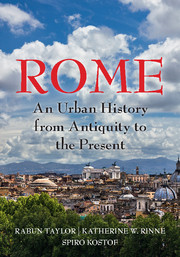Book contents
- Frontmatter
- Dedication
- Epigraph
- Contents
- List of Illustrations
- Acknowledgments
- Map
- INTRODUCTION
- 1 A BEND IN THE RIVER
- 2 A STORYBOOK BEGINNING
- 3 IDEOLOGICAL CROSSFIRE
- 4 BIG MEN ON THE CAMPUS
- 5 RES PUBLICA RESTITUTA
- 6 MEMORIALS IN MOTION: SPECTACLE IN THE CITY
- 7 THE CONCRETE STYLE
- 8 REMAKING ROME'S PUBLIC CORE: I
- 9 REMAKING ROME'S PUBLIC CORE: II
- 10 CRISIS AND CONTINUITY
- 11 RUS IN URBE: A GARDEN CITY
- 12 ADMINISTRATION, INFRASTRUCTURE, AND DISPOSAL OF THE DEAD
- 13 MAPPING, ZONING, AND SEQUESTRATION
- 14 TETRARCHIC AND CONSTANTINIAN ROME
- 15 TROPHIES AND TITULI: CHRISTIAN INFRASTRUCTURE BEFORE CONSTANTINE
- 16 WALLS MAKE CHRISTIANS: FROM FOURTH TO FIFTH CENTURY
- 17 A TALE OF TWO ROMES
- 18 THE ROME OF GOTHS AND BYZANTINES
- 19 CHRISTIAN FOUNDATIONS
- 20 FROM DOMUS LATERANI TO ROMANUM PALATIUM
- 21 THE LEONINE CITY: ST. PETER'S AND THE BORGO
- 22 VIA PAPALIS, THE CHRISTIAN DECUMANUS
- 23 THE URBAN THEATERS OF IMPERIUM AND SPQR
- 24 HOUSING DAILY LIFE
- 25 CHAOS IN THE FORTIFIED CITY
- 26 THE TIBER RIVER
- 27 HUMANIST ROME, ABSOLUTIST ROME (1420–1527)
- 28 PLANNING COUNTER REFORMATION ROME
- 29 PROCESSIONS AND POPULATIONS
- 30 MAGNIFICENT PALACES AND RHETORICAL CHURCHES
- 31 NEOCLASSICAL ROME
- 32 PICTURING ROME
- 33 REVOLUTION AND RISORGIMENTO
- 34 ITALIAN NATIONALISM AND ROMANITÀ
- 35 A CITY TURNED INSIDE OUT
- Glossary of Persons, Places, and Terms
- Works Cited
- Index
7 - THE CONCRETE STYLE
Published online by Cambridge University Press: 05 July 2016
- Frontmatter
- Dedication
- Epigraph
- Contents
- List of Illustrations
- Acknowledgments
- Map
- INTRODUCTION
- 1 A BEND IN THE RIVER
- 2 A STORYBOOK BEGINNING
- 3 IDEOLOGICAL CROSSFIRE
- 4 BIG MEN ON THE CAMPUS
- 5 RES PUBLICA RESTITUTA
- 6 MEMORIALS IN MOTION: SPECTACLE IN THE CITY
- 7 THE CONCRETE STYLE
- 8 REMAKING ROME'S PUBLIC CORE: I
- 9 REMAKING ROME'S PUBLIC CORE: II
- 10 CRISIS AND CONTINUITY
- 11 RUS IN URBE: A GARDEN CITY
- 12 ADMINISTRATION, INFRASTRUCTURE, AND DISPOSAL OF THE DEAD
- 13 MAPPING, ZONING, AND SEQUESTRATION
- 14 TETRARCHIC AND CONSTANTINIAN ROME
- 15 TROPHIES AND TITULI: CHRISTIAN INFRASTRUCTURE BEFORE CONSTANTINE
- 16 WALLS MAKE CHRISTIANS: FROM FOURTH TO FIFTH CENTURY
- 17 A TALE OF TWO ROMES
- 18 THE ROME OF GOTHS AND BYZANTINES
- 19 CHRISTIAN FOUNDATIONS
- 20 FROM DOMUS LATERANI TO ROMANUM PALATIUM
- 21 THE LEONINE CITY: ST. PETER'S AND THE BORGO
- 22 VIA PAPALIS, THE CHRISTIAN DECUMANUS
- 23 THE URBAN THEATERS OF IMPERIUM AND SPQR
- 24 HOUSING DAILY LIFE
- 25 CHAOS IN THE FORTIFIED CITY
- 26 THE TIBER RIVER
- 27 HUMANIST ROME, ABSOLUTIST ROME (1420–1527)
- 28 PLANNING COUNTER REFORMATION ROME
- 29 PROCESSIONS AND POPULATIONS
- 30 MAGNIFICENT PALACES AND RHETORICAL CHURCHES
- 31 NEOCLASSICAL ROME
- 32 PICTURING ROME
- 33 REVOLUTION AND RISORGIMENTO
- 34 ITALIAN NATIONALISM AND ROMANITÀ
- 35 A CITY TURNED INSIDE OUT
- Glossary of Persons, Places, and Terms
- Works Cited
- Index
Summary
AUGUSTUS’ SUCCESSOR, TIBERIUS (14–37 C.E.), SPONSORED ONLY A FEW urban developments in Rome, the most significant being the expansion of the imperial Palatine compound into the Domus Tiberiana, a genuine palace designed to accommodate the growing imperial entourage, especially the Praetorian Guard. Other cohorts of the guard were quartered in a full-scale military camp, the Castra Praetoria, just northeast of the Servian Wall; this was later nested into the Aurelian Wall (see Fig. 80). Caligula (37–41) launched several aggressive building campaigns, some of which died prematurely with their patron. Others were completed by his successors. Claudius (41–54) focused on infrastructure rather than the city's monumental core. The splendid Porta Maggiore, doubling as an aqueduct arcade and a city gate, is his most enduring monument in Rome (Fig. 38). Over it flowed his two great aqueducts, one channel stacked upon the other: the Aqua Claudia and the Anio Novus above, both begun by Caligula. Their arcade of solid peperino stone still dominates the landscape east of the city. Together they augmented the existing water supply by as much as 40 percent. Claudius devised no known monumental baths, water play, or naumachia to justify or advertise them. Yet combined, Frontinus later tells us, the two lines were supplying all 14 city regions from 92 distribution tanks in his time (ca. 97 C.E.). In number, these tanks constituted 37 percent of the total urban network, and in volume 34 percent; the total brought in an astounding (but in Frontinus’ opinion, scandalously underperforming) 333 million liters per day.
This precious glimpse of Rome's “soft” structure at one moment in its history says little about its “hard” aspect, however. After Augustus, the first traceable and truly systemic changes to the urban fabric belonged to Nero (54–68), who took concrete vaulted architecture not only to new heights of creativity, but also into mass production. The central-Italian preference for concrete as a monumental building material developed slowly and incrementally. Writing early in Augustus’ reign, Vitruvius provided a simple formula for this miraculous slurry that hardened into veritable stone, far stronger than any mortar. Its key ingredients were chunks of stone aggregate and a matrix of water, slaked lime, and pozzolana – a volcanic sand that gives concrete its extraordinary strength.
- Type
- Chapter
- Information
- RomeAn Urban History from Antiquity to the Present, pp. 60 - 71Publisher: Cambridge University PressPrint publication year: 2016



